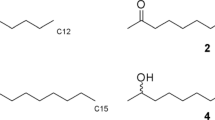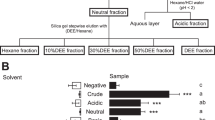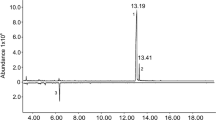Abstract
THERE are numerous reports of the isolation and identification of insect sex pheromones, and recently a termite trail-following pheromone was isolated and identified1, but this is the first isolation and identification of an ant trail pheromone to be reported. We have identified the major volatile component of the trail marking substance laid down by the town ant, Atta texana (Buckley), as methyl 4-methylpyrrole-2-carboxylate (I). The worker ants of Atta texana, whose trail marking substance contains both volatile and nonvolatile components2, readily followed trails made by us with synthesized (I). 
This is a preview of subscription content, access via your institution
Access options
Subscribe to this journal
Receive 51 print issues and online access
$199.00 per year
only $3.90 per issue
Buy this article
- Purchase on Springer Link
- Instant access to full article PDF
Prices may be subject to local taxes which are calculated during checkout
Similar content being viewed by others
References
Matsumura, F., Coppel, H. C., and Akira Tai, Nature, 219, 964 (1968).
Moser, J. C., and Silverstein, R. M., Nature, 215, 206 (1967).
Moser, J. C., and Blum, M. S., Science, 140, 1228 (1963).
Rapoport, H., and Bordner, J., J. Org. Chem., 29, 2727 (1964).
Author information
Authors and Affiliations
Rights and permissions
About this article
Cite this article
TUMLINSON, J., SILVERSTEIN, R., MOSER, J. et al. Identification of the Trail Pheromone of a Leaf-cutting Ant, Atta texana. Nature 234, 348–349 (1971). https://doi.org/10.1038/234348b0
Received:
Issue Date:
DOI: https://doi.org/10.1038/234348b0
This article is cited by
-
Identification of methyl 6-methylsalicylate as the trail pheromone of the Japanese pavement ant Tetramorium tsushimae (Hymenoptera: Formicidae)
Applied Entomology and Zoology (2019)
-
Antennal Olfactory Physiology and Behavior of Males of the Ponerine Ant Harpegnathos saltator
Journal of Chemical Ecology (2018)
-
Early ant trajectories: spatial behaviour before behaviourism
Journal of Comparative Physiology A (2016)
-
Trail Following Response of Larval Cactoblastis cactorum to 2-Acyl-1,3-Cyclohexanediones
Journal of Chemical Ecology (2015)
-
Intracolonial genetic diversity increases chemical signaling by waggle-dancing honey bees, Apis mellifera
Insectes Sociaux (2013)
Comments
By submitting a comment you agree to abide by our Terms and Community Guidelines. If you find something abusive or that does not comply with our terms or guidelines please flag it as inappropriate.



